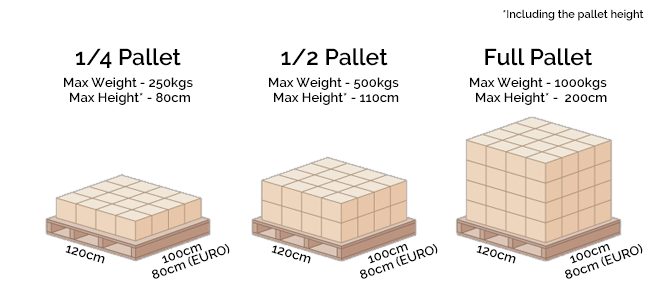Ever wanted to ship a large/heavy item but didn’t know how? Well, your best bet is to send it on a pallet. We’ve come up with this little guide to make whatever you’re sending on a pallet quick and stress free. It’s a lot cheaper and easier than you would imagine! Let’s start with the basics:
What is a pallet? A pallet is a flat transport structure that is designed to support goods and provide stability when being lifted by a forklift, pallet jack, or other jacking device. Since its invention in the twentieth century, its use has dramatically supplanted older forms of crating like the wooden box and the wooden barrel, as it works well with modern packaging like cardboard boxes and Intermodal containers commonly used for bulk shipping. While most pallets are wooden, pallets can also be made of plastic, metal, paper, and recycled materials, so depending on what you need to ship and to where, bear this in mind!
What can I send on a pallet? You would be amazed at some of the items suitable to go through a pallet network, anything from building materials, furniture, domestic appliances, machinery, job lots of smaller, boxed, stackable items going to one destination… The list goes on.
How much will it cost? The cost depends on the location, how fast you need it to get there and the size/weight of the palletised goods. You can get a quote on pallet delivery here: https://parcelbroker.co.uk/pallet-delivery
What size pallet will I need? Choosing the right size and right type of pallet is important for many reasons, but most important are the considerations of maximising your available storage space, reducing transport costs and ensuring goods are handled efficiently during your pallets journey to its destination. Pallets should be large enough to accommodate the shipment without overhang. Anything overhanging the pallet edges will be subjected to impacts that can result in punctures, abrasions, and compression damage. Overhang can also lead to unwanted surcharges for your shipment taking up more space on the vehicle it is being transported in!

How can I prepare my pallet for transit? You will need to ensure your goods aren’t going to get damaged or fall off the pallet in transit. Here’s some tips to remember:
- Use layers of corrugated cardboard that help to evenly distribute the weight of shipments that can be stacked upon one another.
- Use corner boards to increase vertical stacking strength, prevent damage to corner edges and stabilize the load. If possible make sure they cover the full height and length of the load, and use them on all corners.
- Use stretch wrapping (shrink wrap), this is an effective way to keep all pieces of a shipment together. The plastic stretch wrap should first be applied around the pallet and continued upward around the load. Must be tight to prevent load shifting. Stretch wrap is designed to stabilize the load, not to secure it to the pallet. Strapping or banding should be used in conjunction with stretch wrap to secure the load to the pallet.
- Use strapping or banding to prevent pieces from getting lost or separated from the load. It should be drawn tightly to the load which may require running it underneath the top deck boards of the pallet.
That pretty much covers the basics for sending a pallet, we’re always looking for new content so if you have any questions about sending your goods on a pallet feel free to get in touch.